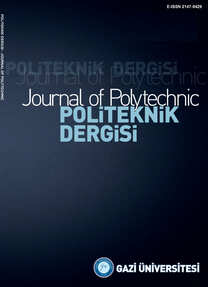Comparison of Methods for Determining Activity from Physical Movements
Physical movement, determining activity, IMU, ANN, CNN
Comparison of Methods for Determining Activity from Physical Movements
Physical Movement, Determining Activity, IMU, ANN, CNN,
___
- [1] N. D. Lane, E. Miluzzo, H. Lu, D. Peebles, T. Choudhury, and A. T. Campbell, “A survey of mobile phone sensing,” IEEE Commun. Mag., 2010.
- [2] W. Zijlstra and K. Aminian, “Mobility assessment in older people: New possibilities and challenges,” European Journal of Ageing. 2007.
- [3] D. Roetenberg, P. J. Slycke, and P. H. Veltink, “Ambulatory position and orientation tracking fusing magnetic and inertial sensing,” IEEE Trans. Biomed. Eng., 2007.
- [4] P. Prasertsung and T. Horanont, “A classification of accelerometer data to differentiate pedestrian state,” in 20th International Computer Science and Engineering Conference: Smart Ubiquitos Computing and Knowledge, ICSEC 2016, 2017.
- [5] X. Su, H. Tong, and P. Ji, “Activity recognition with smartphone sensors,” Tsinghua Sci. Technol., 2014.
- [6] U. Lindemann, A. Hock, M. Stuber, W. Keck, and C. Becker, “Evaluation of a fall detector based on accelerometers: A pilot study,” Med. Biol. Eng. Comput., 2005.
- [7] E. Jovanov, A. Milenkovic, C. Otto, and P. C. De Groen, “A wireless body area network of intelligent motion sensors for computer assisted physical rehabilitation,” J. Neuroeng. Rehabil., 2005.
- [8] E. A. Sağbaş and S. Balli, “Akıllı telefon algılayıcıları ve makine öğrenmesi kullanılarak ulaşım türü tespiti Transportation mode detection by using smartphone sensors and machine learning,” Pamukkale Univ Muh Bilim Derg, 2016.
- [9] J. R. Kwapisz, G. M. Weiss, and S. A. Moore, “Activity recognition using cell phone accelerometers,” ACM SIGKDD Explor. Newsl., 2011.
- [10] M. Shoaib, S. Bosch, H. Scholten, P. J. M. Havinga, and O. D. Incel, “Towards detection of bad habits by fusing smartphone and smartwatch sensors,” in 2015 IEEE International Conference on Pervasive Computing and Communication Workshops, PerCom Workshops 2015, 2015.
- [11] D. Natarajasivan and M. Govindarajan, “Filter Based Sensor Fusion for Activity Recognition using Smartphone,” Int. J. Comput. Sci. Telecommun. J. Homepage, 2016.
- [12] F. Dadashi et al., “A hidden Markov model of the breaststroke swimming temporal phases using wearable inertial measurement units,” in 2013 IEEE International Conference on Body Sensor Networks, BSN 2013, 2013.
- [13] B. J. Mortazavi, M. Pourhomayoun, G. Alsheikh, N. Alshurafa, S. I. Lee, and M. Sarrafzadeh, “Determining the single best axis for exercise repetition recognition and counting on smartwatches,” in Proceedings - 11th International Conference on Wearable and Implantable Body Sensor Networks, BSN 2014, 2014.
- [14] J. J. Guiry, P. van de Ven, and J. Nelson, “Multi-sensor fusion for enhanced contextual awareness of everyday activities with ubiquitous devices,” Sensors (Switzerland), 2014.
- [15] G. M. Weiss, J. L. Timko, C. M. Gallagher, K. Yoneda, and A. J. Schreiber, “Smartwatch-based activity recognition: A machine learning approach,” in 3rd IEEE EMBS International Conference on Biomedical and Health Informatics, BHI 2016, 2016.
- [16] “MTw Avinda Software.” [Online]. Available: https://www.xsens.com/mt-software-suite-mtw-awinda/. [Accessed: 10-Dec-2018].
- [17] X. Xin, C. Wang, X. Ying, and B. Wang, “Deep community detection in topologically incomplete networks,” Phys. A Stat. Mech. its Appl., 2017.
- [18] S. E. Buttrey and C. Karo, “Using k-nearest-neighbor classification in the leaves of a tree,” Comput. Stat. Data Anal., 2002.
- [19] N. Hajibandeh, F. Faghihi, H. Ranjbar, and H. Kazari, “Classifications of disturbances using wavelet transform and support vector machine,” Turkish J. Electr. Eng. Comput. Sci., 2017.
- [20] S. M. S. Shah, S. Batool, I. Khan, M. U. Ashraf, S. H. Abbas, and S. A. Hussain, “Feature extraction through parallel Probabilistic Principal Component Analysis for heart disease diagnosis,” Phys. A Stat. Mech. its Appl., 2017.
- [21] R. Moraes, J. F. Valiati, and W. P. Gavião Neto, “Document-level sentiment classification: An empirical comparison between SVM and ANN,” Expert Syst. Appl., 2013.
- [22] D. P. Kingma and J. L. Ba, “Adam: A method for stochastic gradient descent,” ICLR Int. Conf. Learn. Represent., 2015.
- ISSN: 1302-0900
- Yayın Aralığı: 6
- Başlangıç: 1998
- Yayıncı: GAZİ ÜNİVERSİTESİ
Esra GÜNERİ, Yeliz YÜKSELEN AKSOY
Mehmet Tuncay ÇAĞATAY, Şeyda ÇAĞATAY, Süleyman KARACAN
Comparison of Methods for Determining Activity from Physical Movements
Mücahit ÇALIŞAN, MUHAMMED FATİH TALU
Derin Öğrenme Tabanlı Model ile Bir Olayın Sonraki Olma Zamanının Tahmini
ANIL UTKU, MUHAMMET ALİ AKCAYOL
Design, Development and Evaluation of a New Hand Exoskeleton for Stroke Rehabilitation at Home
